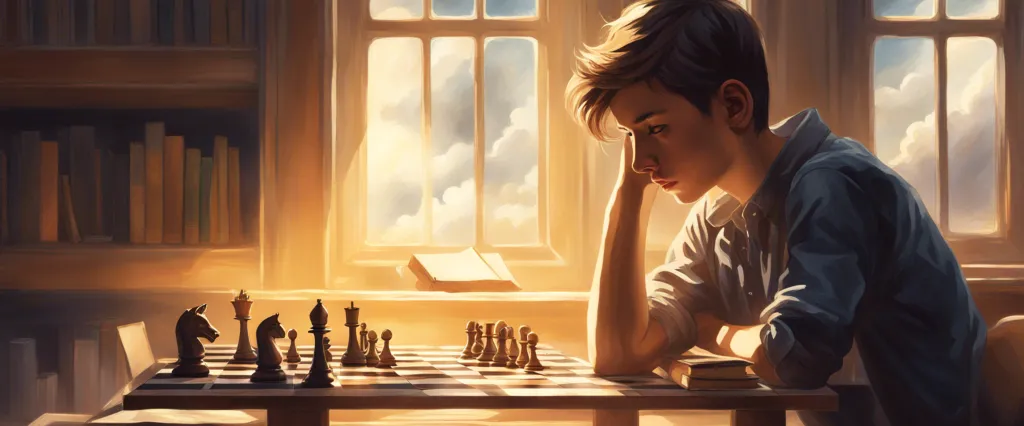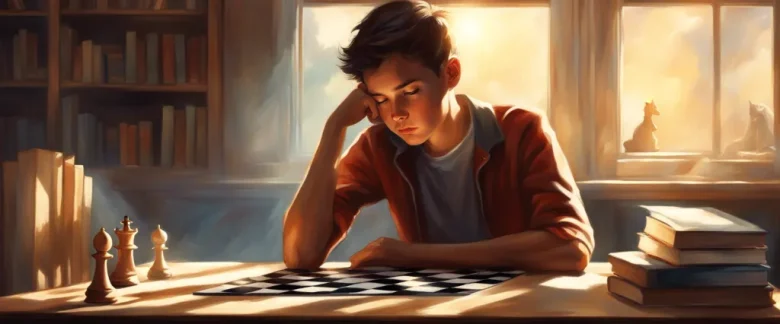In “The Art of Learning,” Josh Waitzkin delivers an extraordinary exploration of the human capacity to acquire skills and excel in any discipline. Drawing from his own experiences as a child prodigy in chess and later, as a champion in the martial art of Tai Chi Chuan, Waitzkin dives deeply into the principles and techniques that have allowed him to achieve remarkable success. Hailed as one of the most successful competitors and coaches in the world, Waitzkin has become a renowned author and teacher, inspiring both top athletes and everyday individuals to unlock their full potential. With transformative anecdotes and practical advice, he reveals the mindset and strategies necessary to cultivate mastery in any field.
Chapter 1: Beginner’s Mind: Embracing a Growth Mindset
Chapter 1 of “The Art of Learning” by Josh Waitzkin is titled “Beginner’s Mind: Embracing a Growth Mindset.” In this chapter, Waitzkin shares his journey from being a chess prodigy to becoming a martial artist and discusses the importance of adopting a growth mindset.
Waitzkin starts by describing his experience as a child chess prodigy, where he faced immense pressure to perform and expectations that he should always win. However, this led to a fixed mindset, as he became afraid of failure and avoided challenging situations. Upon discovering the martial art of Tai Chi, Waitzkin realized that he had to let go of his fixed mindset and develop a beginner’s mind, which allows for growth by embracing challenges and seeing failures as learning opportunities.
He emphasizes the concept of incremental learning, where progress is made by breaking down complex skills into manageable parts and mastering them one at a time. Waitzkin highlights the importance of deep focused learning, which involves immersing oneself fully in the task at hand, aided by introspection and self-awareness.
Waitzkin also discusses the concept of learning from adversity. He shares an incident from a martial arts competition where he struggled against his opponent, but managed to win by adapting his mindset and strategies. Through this experience, he realized that setbacks can fuel personal growth and be transformed into valuable lessons.
In conclusion, Chapter 1 sets the foundation for the book by emphasizing the importance of cultivating a growth mindset, adopting a beginner’s mind, and viewing challenges and setbacks as opportunities for learning and growth. Waitzkin encourages readers to let go of a fixed mindset, embrace the unknown, and approach learning with curiosity and perseverance.
Chapter 2: The Power of Presence: Cultivating Focus and Awareness
Chapter 2 of “The Art of Learning” by Josh Waitzkin is titled “The Power of Presence: Cultivating Focus and Awareness.” In this chapter, Waitzkin explores the importance of maintaining a state of presence and how it contributes to peak performance.
Waitzkin starts by recounting his experiences as a young chess prodigy and how his ability to stay present in the midst of intense competition allowed him to perform at his best. He emphasizes that presence is not about being overly intense or rigid but about being completely in tune with the present moment, free from external distractions and internal thoughts.
He then delves into the concept of the inner game, which refers to the battle that takes place within an individual’s mind. Waitzkin highlights the significance of cultivating focus and awareness to triumph in this inner game. By having a clear and uncluttered mind, one can better discern patterns, anticipate opponents’ moves, and make better decisions.
Waitzkin shares his personal techniques for achieving this state of presence. These include developing a ritual before engaging in any activity, using breath control as an anchor for focus, and cultivating awareness of the body to avoid tension or relax deeply.
Furthermore, he discusses how presence can be cultivated beyond competitive activities and applied to other aspects of life, such as learning, relationships, and decision-making. Through numerous examples and anecdotes, Waitzkin encourages readers to embrace presence as a tool for success and fulfillment.
In summary, Chapter 2 emphasizes the importance of presence in achieving peak performance. Waitzkin provides insights into how to cultivate focus and awareness, and highlights the broad applicability of these skills in various areas of life.
Chapter 3: Making Smaller Circles: Developing Deep Understanding and Mastery
Chapter 3 of “The Art of Learning” by Josh Waitzkin, titled “Making Smaller Circles: Developing Deep Understanding and Mastery,” delves into the concept of breaking down complex skills or subjects into smaller, manageable components to develop a deep understanding and foster mastery.
Waitzkin introduces the idea of “making smaller circles” by referencing the Chinese philosophy of tai chi. He explains that in tai chi, practitioners strive to make their movements as small and efficient as possible, harnessing their energy, focus, and precision. He applies this principle to various disciplines, including chess and martial arts, to emphasize the importance of simplicity and clarity.
Waitzkin discusses the importance of taking a holistic approach to learning. He recommends building a solid foundation by immersing oneself in the fundamental principles and concepts of a particular skill. By mastering the basics and understanding the underlying principles, individuals can then begin to develop their own unique style or approach.
The chapter also explores the concept of chunking, which involves breaking down complex information into smaller chunks, or patterns, that can be easily memorized and applied. Waitzkin explains that by recognizing and internalizing these patterns, one can develop a deeper understanding of the subject matter and make faster, more accurate decisions.
Moreover, Waitzkin emphasizes the significance of a growth mindset and the willingness to embrace challenges and setbacks as opportunities for growth. By persevering through obstacles and continually seeking out new challenges, individuals can enhance their learning process and develop mastery in their chosen field.
In summary, Chapter 3 of “The Art of Learning” highlights the importance of breaking down complex skills or subjects into smaller, manageable components to develop a deep understanding and foster mastery. It delves into the concepts of making smaller circles, building a solid foundation, chunking, and having a growth mindset. By applying these principles, individuals can accelerate their learning and achieve proficiency in various disciplines.
Chapter 4: The Soft Zone: Harnessing the Flow State for Peak Performance

Chapter 4 of “The Art of Learning” by Josh Waitzkin is titled “The Soft Zone: Harnessing the Flow State for Peak Performance.” In this chapter, Waitzkin explores the concept of the “flow state” and how it can be utilized to achieve peak performance in various fields.
Waitzkin begins by recounting his experiences as a chess prodigy and a world champion in martial arts. He describes moments where he experienced a state of full immersion and effortless focus, which he calls the “flow state.” Waitzkin explains that the flow state is a mental state in which individuals are fully absorbed in an activity, feeling energized and focused, and performing at their peak without conscious effort.
To harness the flow state, Waitzkin emphasizes the importance of mental preparation. He delves into topics such as relaxation techniques, visualization, and meditation, which help to quiet the mind and create the optimal conditions for entering the flow state. In addition, he stresses the significance of finding the right balance between discipline and intuition, as both are essential for peak performance.
Waitzkin also explores the notion of “embracing the suck,” which involves embracing the challenges and setbacks encountered during the learning process. He explains that when individuals learn to embrace and overcome these difficulties, they build resilience and develop the capacity to enter the flow state more readily.
Throughout the chapter, Waitzkin shares personal anecdotes and provides practical advice on how individuals can cultivate the flow state to enhance their performance in various areas of their lives. By incorporating relaxation techniques, visualization, meditation, and embracing challenges, individuals can enter the flow state more frequently and achieve their fullest potential.
Chapter 5: Investment in Loss: Learning from Setbacks and Adversity
Chapter 5 of “The Art of Learning” by Josh Waitzkin is titled “Investment in Loss: Learning from Setbacks and Adversity.” In this chapter, Waitzkin explores the importance of embracing failure and adversity as an integral part of the learning process.
Waitzkin starts by sharing his experience as a young chess prodigy and the pressure he felt to always win. He recounts a game in which he blundered and lost, which led him to question his abilities. However, instead of letting the loss discourage him, he saw it as an opportunity to learn and grow. This mindset shift allowed him to view his losses as investments in his long-term development.
Waitzkin then introduces the concept of “investing in loss,” which involves seeking out situations where one is likely to fail and using those experiences to gain valuable knowledge and insights. He emphasizes that setbacks and failures are not indicative of one’s incompetence, but rather valuable opportunities for improvement. By observing the mistakes, analyzing the root causes, and learning from them, one can refine their skills and knowledge.
Through various examples, Waitzkin explores how investment in loss applies to different aspects of life, including chess, martial arts, and everyday challenges. He shares his journey in tai chi push hands, a martial art that focuses on using an opponent’s energy against them. He explains how initially losing multiple times to skilled opponents motivated him to understand and embrace the underlying principles of the discipline.
Overall, Chapter 5 highlights the significance of embracing setbacks and adversity as pivotal components of growth and learning. It teaches that failing is not a reflection of one’s abilities but an essential element in the development of expertise. By adopting an attitude of curiosity, resilience, and continuous self-reflection, individuals can transform failures into invaluable learning experiences.
Chapter 6: Using Adversity: Transforming Challenges into Opportunities
Chapter 6 of “The Art of Learning” by Josh Waitzkin explores the concept of using adversity to transform challenges into opportunities for growth and mastery. Waitzkin, a former chess prodigy and martial arts champion, shares his personal experiences and insights on how he has utilized adversity to develop his skills and mindset.
The chapter begins with Waitzkin recalling his intense martial arts training where he faced physical and mental challenges that pushed him to the brink of exhaustion. He highlights the importance of embracing difficult situations rather than shying away from them. By actively seeking out challenging opponents or tasks, individuals can accelerate their learning and development.
Waitzkin emphasizes the significance of the learning process and how it can be enhanced through adversity. He notes that when faced with setbacks or failures, it is crucial to let go of ego and focus on the lessons embedded within those moments. These experiences enable individuals to increase their self-awareness, refine their strategies, and ultimately become more resilient and adaptable.
The chapter also delves into the concept of stress and its potential benefits. Waitzkin explains that stress can be harnessed as a powerful tool for growth, enabling individuals to develop mental toughness and surpass their previous limitations. By reframing stress as an opportunity rather than a threat, one can perform better under pressure.
In conclusion, Chapter 6 of “The Art of Learning” emphasizes the transformative power of adversity. Waitzkin advises readers to approach challenges with an open mind and embrace the opportunities they present for personal growth. Through this process, individuals can cultivate resilience, self-awareness, and the ability to use adversity as a productive force in their pursuit of mastery.
Chapter 7: Downhill Learning: Leveraging Prior Knowledge and Skills
Chapter 7: Downhill Learning: Leveraging Prior Knowledge and Skills of Josh Waitzkin’s book “The Art of Learning” focuses on the concept of leveraging prior knowledge and skills to accelerate the learning process and achieve mastery. Waitzkin shares his personal experiences and strategies to help readers understand the importance of building on existing competencies.
Waitzkin begins by describing his journey in the art of push hands, a form of martial arts. He explains how he initially struggled to adapt his chess skills to this new discipline, realizing that he needed to discard his existing frameworks and embrace a fresh learning approach. This experience taught him the value of leveraging existing skills while remaining open to new possibilities.
To leverage prior knowledge effectively, Waitzkin emphasizes the importance of conscious mental processing and self-analysis. He encourages readers to reflect on their strengths and weaknesses, identifying areas of crossover and synergy between different domains or skills. By doing this, one can harness their existing competencies and apply them to new challenges, accelerating the learning process.
Waitzkin also introduces the concept of “downhill learning,” which involves learning something new that is somewhat similar to a skill one already possesses. This approach allows individuals to transfer their existing knowledge and techniques more readily, enabling them to progress rapidly.
Additionally, Waitzkin advises readers to seek out diverse perspectives and experiences to expand their repertoire of skills. By exposing oneself to different disciplines and approaches, one can extract lessons and techniques that can be applied to their own field of expertise.
In conclusion, Chapter 7 of “The Art of Learning” emphasizes the power of leveraging prior knowledge and skills to enhance the learning process. By consciously reflecting on strengths and weaknesses, embracing new approaches, and seeking diverse experiences, individuals can accelerate their journey towards mastery.

Chapter 8: The Illusion of the Final Goal: Embracing Lifelong Learning and Growth
Chapter 8 of “The Art of Learning” by Josh Waitzkin, titled “The Illusion of the Final Goal: Embracing Lifelong Learning and Growth,” explores the concept of continual development and the pitfalls of fixating on achieving a final goal. Waitzkin emphasizes the importance of embracing a lifelong learning mindset and the need to shift our focus from external validation to internal growth.
The chapter begins with Waitzkin’s personal anecdote of winning his first Tai Chi push hands world championship. He delves into the emptiness he felt after achieving this long-desired goal, realizing that the final destination was not as fulfilling as he had anticipated. This realization led him to reflect on the nature of goals and the importance of finding joy and fulfillment in the process of learning and growth itself.
Waitzkin introduces the concept of the “internal journey,” which involves understanding one’s own personal growth and development through the pursuit of mastery in any discipline. He emphasizes that the goal should not be the ultimate achievement but rather the continuous improvement and expansion of one’s skills and knowledge.
Furthermore, he explores the dangers of fixating on external validation and the negative impact it can have on the learning process. He encourages readers to shift their mindset from seeking praise and approval to cultivating a deep sense of curiosity, self-awareness, and love for the process of learning.
Waitzkin highlights the importance of embracing failure and setbacks as opportunities for growth and learning. He advises readers to cultivate a resilient mindset, viewing setbacks as valuable feedback rather than personal failures. By doing so, individuals can overcome the fear of failure and embrace the continuous learning journey.
In summary, Chapter 8 of “The Art of Learning” emphasizes the need to shift from a fixation on final goals to embracing lifelong learning and growth. Josh Waitzkin encourages readers to find fulfillment in the process of mastery, focus on internal development rather than external validation, and embrace failure as an essential stepping stone to growth.
After Reading
In conclusion, “The Art of Learning” by Josh Waitzkin provides valuable insights into the mindset and techniques required to become a master in any field. Waitzkin’s personal journey, from a chess prodigy to a competitive martial artist, highlights the importance of cultivating a growth mindset, embracing failure as a learning opportunity, and developing a strong foundation of fundamentals. His emphasis on the integration of mind and body, the power of focus and presence, and the significance of finding one’s own unique style contributes to a comprehensive understanding of the art of learning. Furthermore, Waitzkin’s practical advice and relatable anecdotes make the book not only informative but also highly engaging. Overall, “The Art of Learning” serves as a powerful guide for individuals seeking to excel in their chosen pursuits by harnessing the power of dedication, resilience, and continuous growth.
1. Self-directed Behavior” by David L. Watson: This book is a must-read for anyone looking to gain control over their own behavior and achieve personal growth. Watson provides practical strategies and techniques to foster self-directed change, making it an invaluable resource for those seeking to improve their lives.
2. Quiet” by Susan Cain: After delving into “The Art of Learning” by Josh Waitzkin, “Quiet” provides a refreshing perspective on the power of introversion. Cain explores the virtues and strengths of introverts in a society that often values extroversion. This thought-provoking book challenges traditional notions of success and encourages readers to embrace their own unique qualities.
3. How to Win Friends and Influence People” by Dale Carnegie: Building effective relationships is crucial for personal and professional success. “How to Win Friends and Influence People” offers timeless wisdom on interpersonal skills and communication. It complements “The Art of Learning” by providing practical advice on developing meaningful connections with others and leveraging those relationships to achieve personal and professional goals.
4. Atomic Habits” by James Clear: In “The Art of Learning,” Josh Waitzkin emphasizes the importance of developing disciplined habits. “Atomic Habits” further expands on this concept, offering readers a comprehensive guide to transforming their habits for long-term success. Clear presents actionable strategies for building and breaking habits, making it an essential read for anyone looking to optimize their daily routines.
5. Mindset: The New Psychology of Success” by Carol S. Dweck: Mindset plays a critical role in learning and growth. Dweck’s book explores the power of adopting a growth mindset, which embraces challenges, learns from failures, and persistently strives for improvement. After reading “The Art of Learning,” “Mindset” complements it by providing a psychological framework to enhance your ability to thrive and adapt in various areas of life.



